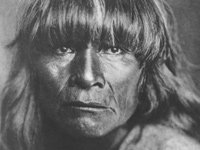
Study Guide
Grades 7-12, College, Adult
Directed by Anne Makepeace
DVD Purchase $295, Rent $95
, Rent $95
US Release Date: 2000
Copyright Date: 2000
DVD ISBN: 1-59458-129-0
VHS ISBN: 1-56029-838-3
Subjects
American Studies
Anthropology
Art/Architecture
Biography
Ecology
Geography
History
Human Rights
Humanities
Indigenous Peoples
Native Americans
Photography
Social Justice
Social Psychology
Sociology
Awards and Festivals
ALA Notable Videos for Adults List
Sundance Film Festival
John E. O'Connor Film of the Year Award, American Historical Association
Gold Hugo, Chicago International Television Competition
Gold Award, Special Jury Prize, Houston WorldFest
CINE Golden Eagle
Best Documentary, MountainFilm, Telluride
Audience Award, Best Documentary, Aspen Filmfest
Audience Award, Best Documentary, Newport Beach Film Festival
Best Documentary, New Jersey International Film Festival
Best Environmental Film, Vermont International Film Festival
Grand Festival Award, Historical Documentary, Berkeley Film & Video Festival
Award of Commendation, Visual Anthropology Film/Video Festival
Best Documentary, Saguaro International Film Festival
Musée de l'Homme, Paris
Double Take Documentary Film Festival
Environmental Film Festival in the Nation's Capital
Beeldvoorbeeld, Amsterdam
Munich International Film Festival
Santa Barbara International Film Festival
Lake Tahoe International Film Festival
Nashville International Film Festival
Florida International Film Festival
Hawaii International Film Festival
Canyonlands Film Festival
Seattle International Film Festival
First Peoples' Festival, Montreal
St.Louis International Film Festival
Denver International Film Festival
Hot Springs Documentary Film Festival
American Indian Film Festival
Singapore International Film Festival
Heard Museum Indigenous Film Festival
Edward S. Curtis and the North American Indians
An in-depth portrait of Edward S. Curtis, the preeminent photographer of North American Indians.
 |
"Offers an extraordinary experience of living history. It cannot be praised enough." Alan Trachtenberg, Neil Gray Professor of English and American Studies, Yale University |
Edward S. Curtis (1868-1952) was a driven, charismatic, obsessive artist, a pioneer photographer who set out in 1900 to document traditional Indian life. He rose from obscurity to become the most famous photographer of his time, created an enormous body of work -- 10,000 recordings, 40,000 photographs, and a full length ethnographic motion picture -- and died poor and forgotten. His work was rediscovered in the 1970s and is now synonymous with photography of Indians.
Coming to Light tells the dramatic story of Curtis' life, the creation of his monumental work, and his changing views of the people he set out to document. The film also gives Indian people a voice in the discussion of Curtis' images. Hopi, Navajo, Eskimo, Blackfeet, Crow, Blood, Piegan, Suquamish, and Kwakiutl people who are descended from Curtis subjects or who are using his photographs for cultural preservation respond to the pictures, tell stories about the people in the photographs, and discuss the meaning of the images.
In 1900, Curtis attended a Piegan Sundance, a ceremony that had recently been outlawed. Curtis believed this would be the last Sundance, and it was this experience that set him on his path to document traditional Indian cultures. Eighty years later, some of Curtis' photographs inspired the Piegans to revive the ceremony, and it is still going strong today. The documentary begins with footage shot at a contemporary Piegan Sundance last year intercut with Curtis' 1900 photographs that led to its revival.
When Curtis began photographing Indians, he believed that their cultures were vanishing. When he finished in 1930, his own work vanished into obscurity, then was rediscovered in the 1970s and helped to inspire the revival of traditional culture on many reservations.
Coming to Light presents a complex, dedicated, flawed life, and explores many of the ironies inherent in Curtis's story, the often controversial nature of his romantic images, and the value of the photographs to Indian people and to all Americans today.
Reviews
"COMING TO LIGHT tells more than the story of its main subject, 'Edward S. Curtis and the North American Indians.' It tells, too, of the tragedy of cultural loss and hopes for recovery of memory. The film honors the great achievements of Curtis by placing his pictures in a vibrant frame of sorrow, desire, and promise. In its sensitive and intelligent fusion of image, sound, and story, the film offers an extraordinary experience of living history. It cannot be praised enough."
"The Odyssean photographic career and poignantly forlorn private life of Edward S. Curtis are charted with impressive sensitivity in this very welcome portrait...It's an outstanding subject, one that...emerges compellingly in documentary form."
"Beautifully filmed, skillfully edited and well-paced, Coming To Light is highly recommended for courses on North American Indians, visual anthropology, and American popular culture. Well researched and deftly touching on the complex politics of cross-cultural visual representation, Makepeace's film exhibits a balanced perspective on Curtis as a trailblazer in visual ethnography."
"A beautifully crafted epic..."
"An unusually well-balanced view of Edward Curtis' life and works as the best known photographer of North American Indian people during the first part of the twentieth century."
"Remarkable, a fascinating and thorough look at a photographer whose 40,000 images recorded Native American life."
"A phenomenal film. Well crafted, intelligent, and beautiful to behold...brings historical depth and cultural context to our understanding of Curtis' photographs and his monographs on Native Americans...I highly recommend this piece for use in Art History courses, Photography courses, Native American Studies, and especially in Anthropology."
"Anne Makepeace has done total justice to the myth and the man that Edward S. Curtis was. Coming to Light is a thoroughly researched masterpiece of its own, honoring the man whose portraits continue to honor the beauty and glory of American Indians."
"This superlative movie will serve the classroom well, for its historical value as well as the many issues it raises: the nature of culture, cultural representation and revitalization; Native perspectives, and the ongoing relationship between Indians and non-Indian"